bodylanguage话题词汇
- 格式:pptx
- 大小:2.01 MB
- 文档页数:30
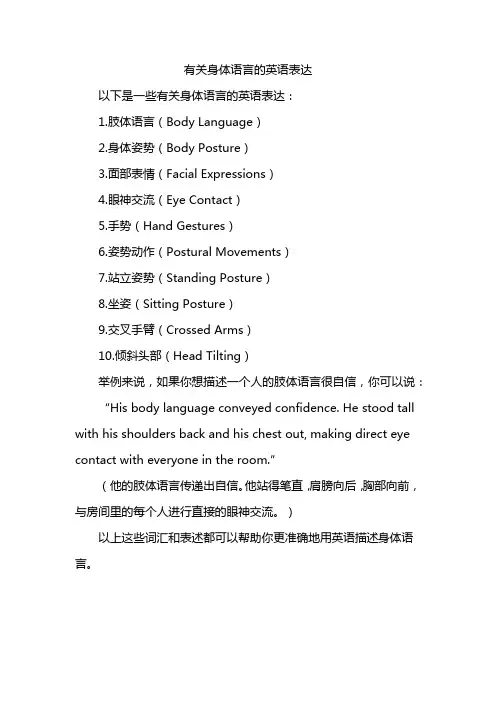
有关身体语言的英语表达
以下是一些有关身体语言的英语表达:
1.肢体语言(Body Language)
2.身体姿势(Body Posture)
3.面部表情(Facial Expressions)
4.眼神交流(Eye Contact)
5.手势(Hand Gestures)
6.姿势动作(Postural Movements)
7.站立姿势(Standing Posture)
8.坐姿(Sitting Posture)
9.交叉手臂(Crossed Arms)
10.倾斜头部(Head Tilting)
举例来说,如果你想描述一个人的肢体语言很自信,你可以说:“His body language conveyed confidence. He stood tall with his shoulders back and his chest out, making direct eye contact with everyone in the room.”
(他的肢体语言传递出自信。
他站得笔直,肩膀向后,胸部向前,与房间里的每个人进行直接的眼神交流。
)
以上这些词汇和表述都可以帮助你更准确地用英语描述身体语言。
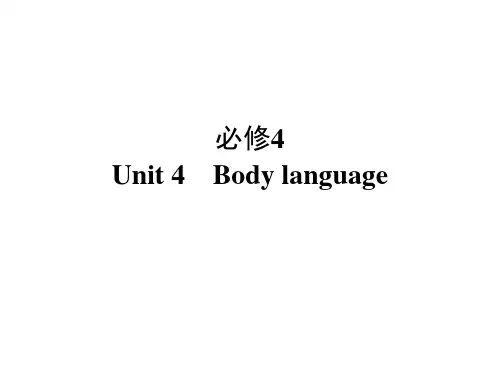
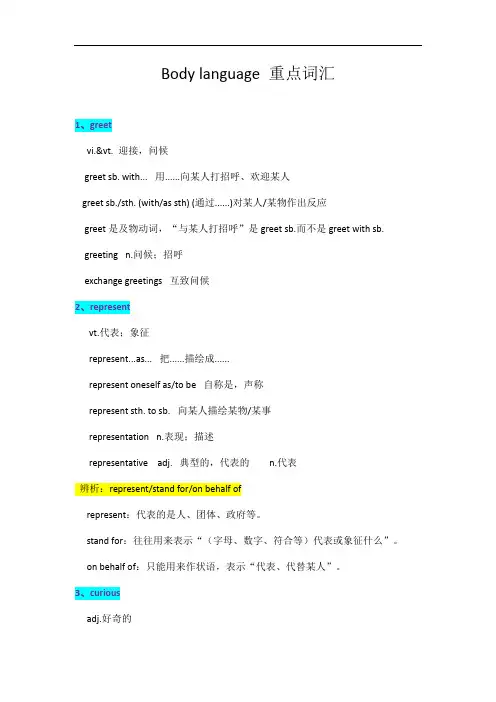
Body language 重点词汇1、greetvi.&vt. 迎接,问候greet sb. with...用......向某人打招呼、欢迎某人greet sb./sth. (with/as sth) (通过......)对某人/某物作出反应greet是及物动词,“与某人打招呼”是greet sb.而不是greet with sb. greeting n.问候;招呼exchange greetings互致问候2、representvt.代表;象征represent...as...把......描绘成......represent oneself as/to be自称是,声称represent sth. to sb.向某人描绘某物/某事representation n.表现;描述representative adj.典型的,代表的n.代表辨析:represent/stand for/on behalf ofrepresent:代表的是人、团体、政府等。
stand for:往往用来表示“(字母、数字、符合等)代表或象征什么”。
on behalf of:只能用来作状语,表示“代表、代替某人”。
3、curiousadj.好奇的be curious about sth.对......感到好奇be curious to do sth.很想做......;急于做......4、approachvt.&vi.接近;靠近n.接近;途径approach to sth./doing sth.解决......的方法make an approach to sb.想接近某人be approach to...(与......)差不多5、defendvt.保护;保卫defend...against/from防御;保卫......以免受defend oneself自卫defend sb. in court在法庭上为某人辩护辨析:defend/protect/guarddefend:“保卫;防御”,应用范围很广,其宾语可以是国家、权利、名誉等。
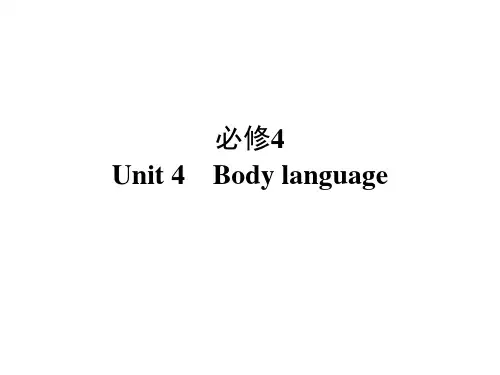
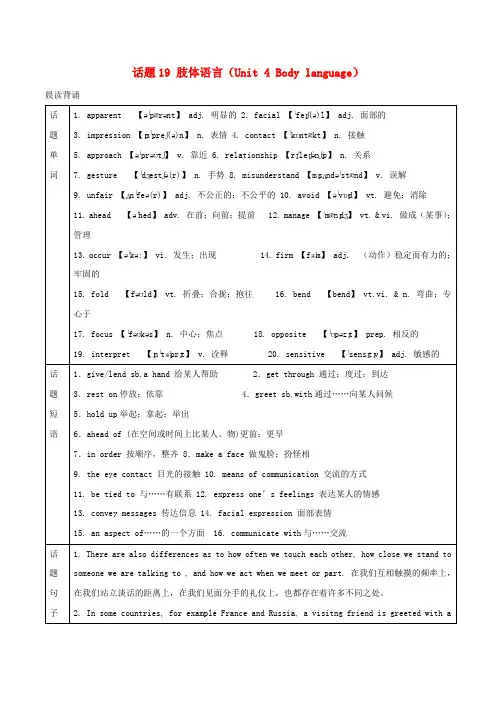
话题19 肢体语言(Unit 4 Body language)晨读背诵kiss o n the cheek. 有些国家,如法国和俄罗斯,人们在来访的朋友的脸颊上亲吻表示欢迎。
3. We can learn a lot about what a person is thinking by watching his or her body language. 我们能够通过一个人的身体的动作了解他的许多所思所想。
4.And if we are feeling down or lonely,there is nothing better than to see the smiling face of a good friend. 如果我们情绪低落或感到孤独,那么没有比看到好友的笑脸更好的了。
5.While there are many different interpretations of our body language,some gestures seem to be universal.尽管对于身势语的解释五花八门,但某些手势语似乎是全球通用的。
6.What are some situations where we need to be very careful about our body language and gestures?在什么样的场合我们需要注意我们的身势语和姿势呢?7. But we found that the first impression begins with a handshake that set the tone for the rest of the interview. 但是我们发现第一印象是以握手开始的,并为面试的余下部分定下基调。
篇章模板When we communicate with other people it is not only our words that contain the meaning. An important part of that meaning comes from what is called “non-verbal (非言辞的) communication”. By this we mean facial expression, gestures with hands, arms, legs, the way we sit or stand, the way we touch other people, the distance we keep between ourselves and the people we are talking to, our dress and our appearance. All these say something to other people.汉语大意:当我们与其他人交流的时候,我们的语言并不是唯一包含意思的。

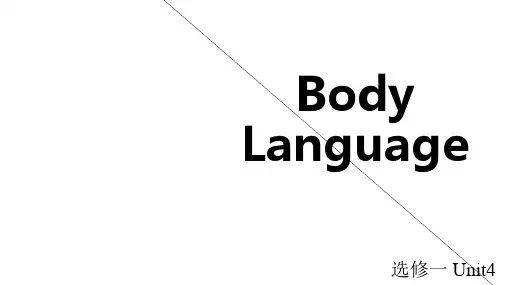
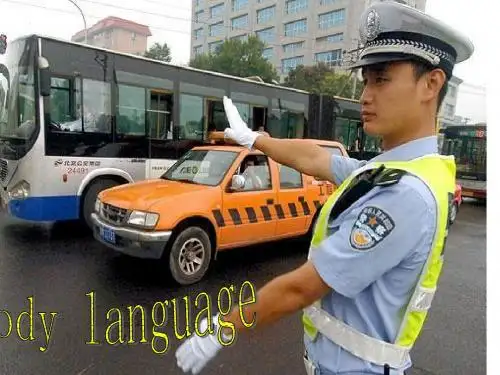
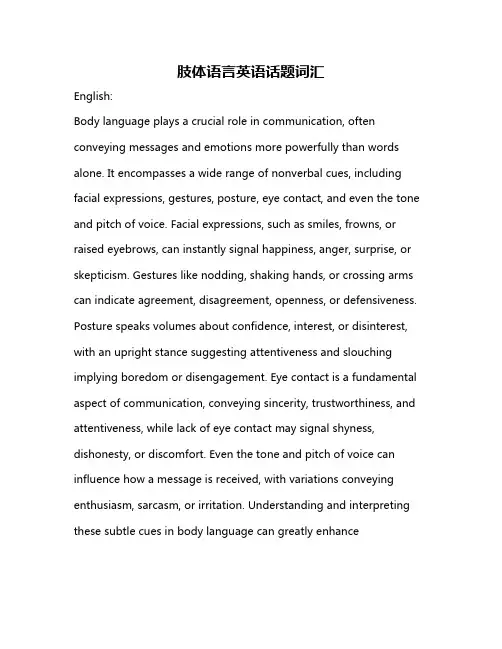
肢体语言英语话题词汇English:Body language plays a crucial role in communication, often conveying messages and emotions more powerfully than words alone. It encompasses a wide range of nonverbal cues, including facial expressions, gestures, posture, eye contact, and even the tone and pitch of voice. Facial expressions, such as smiles, frowns, or raised eyebrows, can instantly signal happiness, anger, surprise, or skepticism. Gestures like nodding, shaking hands, or crossing arms can indicate agreement, disagreement, openness, or defensiveness. Posture speaks volumes about confidence, interest, or disinterest, with an upright stance suggesting attentiveness and slouching implying boredom or disengagement. Eye contact is a fundamental aspect of communication, conveying sincerity, trustworthiness, and attentiveness, while lack of eye contact may signal shyness, dishonesty, or discomfort. Even the tone and pitch of voice can influence how a message is received, with variations conveying enthusiasm, sarcasm, or irritation. Understanding and interpreting these subtle cues in body language can greatly enhancecommunication effectiveness, fostering better connections and relationships.Translated content:肢体语言在交流中起着至关重要的作用,通常比单纯的语言更能传达信息和情感。
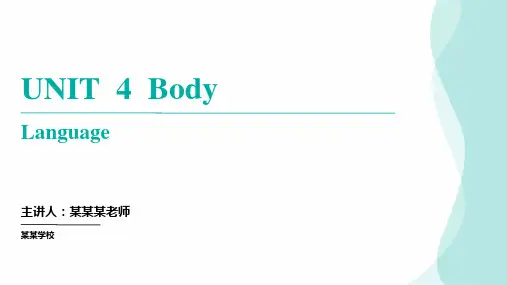
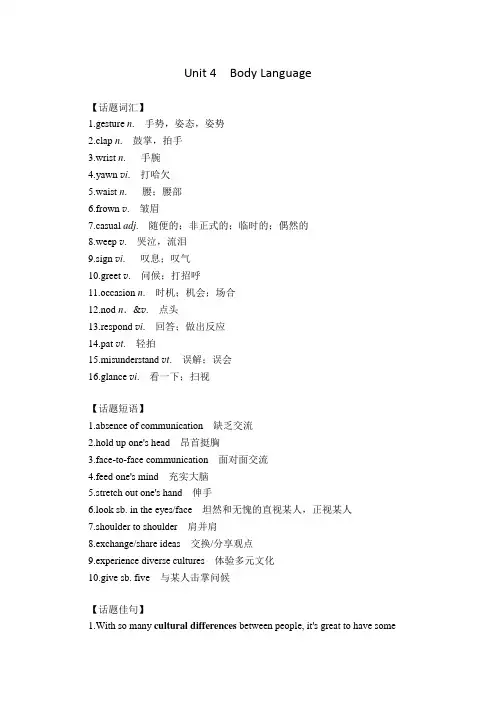
Unit 4Body Language【话题词汇】1.gesture n. 手势,姿态,姿势2.clap n. 鼓掌,拍手3.wrist n. 手腕4.yawn v i. 打哈欠5.waist n. 腰;腰部6.frown v. 皱眉7.casual adj. 随便的;非正式的;临时的;偶然的8.weep v. 哭泣,流泪9.sign v i. 叹息;叹气10.greet v. 问候;打招呼11.occasion n. 时机;机会;场合12.nod n.&v. 点头13.respond v i. 回答;做出反应14.pat v t. 轻拍15.misunderstand v t. 误解;误会16.glance v i. 看一下;扫视【话题短语】1.absence of communication 缺乏交流2.hold up one's head 昂首挺胸3.face-to-face communication 面对面交流4.feed one's mind 充实大脑5.stretch out one's hand 伸手6.look sb. in the eyes/face 坦然和无愧的直视某人,正视某人7.shoulder to shoulder 肩并肩8.exchange/share ideas 交换/分享观点9.experience diverse cultures 体验多元文化10.give sb. five 与某人击掌问候【话题佳句】1.With so many cultural differences between people, it's great to have somesimilarities in body language. We gave away more by gestures than by words.人们之间的文化差异如此之多,好在肢体语言有一些相似之处。
Unit 2 Body language 背记重点1. communication skills 交流技巧communicate with sb. 与某人沟通e.g. I like to communicate with the old. 我喜欢与老人交流。
2. the meaning of ……的意思e.g. If you don’t know the meaning of the word, please look it up in a dictionary.如果你不知道这个词的意思,请查一下字典。
3. make an impression on sb.= leave an impression on sb.= give sb. a good impressione.g. He made a good first impression on her father. 他给她的父亲留下了很好的第一印象。
4. take place 有计划地发生注意:它无被动语态(Unit5内容)e.g. The meeting will take place soon.会议即将举行。
5. remind sb. of/about sth. 使某人想起某事;提醒某人某事e.g. This old picture reminds me of my childhood in the country.这张老图片使我想起了我在农村的童年。
remind sb. that +从句提醒某人……e.g. I’m calling you to remind you that we’ll meet at the school gate tomorrow morning.我打电话给你是为了提醒你我们明天早上要在学校门口见面。
6. instead of 代替,而不是instead of doing sth. 代替做某事People always choose Debbie instead of me. 人们总是选择Debbie而不是我。
肢体语言在我们的日常交流中扮演着重要的角色。
下面我们一起来讨论一下肢体语言是如何在我们的日常交流中发挥关键作用的。
Body language, important language肢体语言,重要的语言湖北 韩 蕾主题语境:肢体语言的重要性篇幅:359词建议用时:6分钟1 Have you ever noticed when someone s behavior is completely inconsistent with what he/she says? Or, have you ever felt hard to control your bodies in certain situations because all you think of is how nervous you are? Then today let s discuss how non⁃verbal signals can play a key role in our daily communication.2 Studies have shown that in the process of communication, non⁃verbal expression has 65 per cent to 93 per cent more influence than actual text. This means that “how to say” is more important than “what to say”.3 We interviewed Emilie Suter, a senior student of EHL. She believes that the import⁃ance of body language is reflected in the ability to help people in the process of communica⁃tion. It helps people have a better understanding of the overall situation, and thus adjust the content of the conversation and voice intonation (声调). Body language is the best explanation of the behavioral psychology of individuals and groups.4 In the real workplace, body language is more important than you think! Without proper body language, you may find yourself trapped in a circle where you can t integrate with the external environment. Therefore, in addition to paying attention to your body language, you should always pay attention to how people around you use body language to express their opinions—this allows you to accurately determine your next move.5 Fidgeting (坐立不安) may mean that there is a lack of interaction between the two sides of the conversation. Turning to other directions rather than talking to each other, or crossing his/her hands to his/her chest can mean that he/she does not agree with your opinion, or that the content of the conversation gives him/her a tendency to close his/her mind. Loich Batumba, vice president of the student council of EHL, says that he clearly remembers similar experiences: “At the time of my first interview, my interviewer and I barely communicated eye⁃to⁃eye, so I could clearly feel that there was a lack of inter⁃est between our conversations.”6 How to establish a good personal impression is a topic that people have repeatedly discussed. Interestingly, what we see often is the most important criterion for us to judge others. This has increased the importance of physical actions for us.ReadingCheckInference Detail Detail 1. The two questions at the beginning of the text are intended to .A. let the readers answer themB. introduce the subject of the textC. question the function of body languageD. ask the readers if they have any non⁃verbal signals while talking2. Why is body language important in communication according to the text?A. It helps people understand the overall situation.B. It determines the content of the conversation.C. It prevents people from high voice intonation.D. It reflects an individual s ability to communicate.3. What does it mean if an interviewer does not look at you?A. He/she is thinking deeply of your opinion.B. He/she is a shy or uncommunicative person.C. He/she is very satisfied with what you say.D. He/she is not interested in your conversation.LanguageStudyDifficult sentences in the text1. Turning to other directions rather than talking to each other, or crossing his/her hands to his/her chest can mean that he/she does not agree with your opinion, or that the content of the conversation gives him/her a tendency to close his/her mind. 转向其他方向而不是相互交谈,或者双手交叉在胸前,可能意味着他/她不同意你的观点,或者谈话的内容使他/她倾向于封闭自己的思想。
选择性B1 Unit4 Body Language1.vary from …to…在…之间变化不等various kinds of \ a variety of 各种各样2.make eye contact目光接触3.be appropriate to适合……4.a way to do / of doing 做某事的方式5.approve of sth 赞成/同意某事approve of sb/sb’s doing sth赞成/同意某人做某事6.demonstrate respect to 对…表示尊敬7.witness sth目击/见证...(a) witness to ……的见证者目击者8.be identical to与……相同9.interpret…as…把…理解为…10.differ from/be different from 区别于…11.by contrast 相比之下12.by parison (与)……比较13.make inferences 推理推断14.sb be employed in doing sth.employ oneself in doing sth.忙于做某事15.be occupied with sth= be occupied in doing sth.忙于做某事16.kiss sb on the cheek亲吻某人脸颊seize sb. by the arm 抓住某人的胳膊hit sb in the stomach 打在某人肚子上17.bow to sb.向某人鞠躬18.do sb. a favor 帮某人的忙be in favor of支持,赞成19.get through difficult situations 经历困难20.feel down 感到沮丧情绪低落21.in other words 换句话说22.straighten up 直起来,整理,收拾整齐23.what makes sb. tick使某人这样做的原因24.have a tendency to do sth.tend to do 有做某事的倾向\趋势25.be ashamed of sth/ doing sth. 为感到羞愧26.distract one’s attention 分散注意力distract sb from sth 转移注意力;使分心27.distinguish ...from... 区分\辨别distinguish between ...and ...28.have conflicts with sb. over sth.在某事上与某人有冲突29.at work 在工作;有某种影响30.lean forward 向前倾31.bend/ lower one’s head 低下头32.have one’s arms crossed 双手交叉33.stare at sb.盯着看glance at 瞥一眼,扫视34.bother to do sth. 费心做某事bother sb.with sth.(拿某事)烦扰某人35.adjust to sth /doing sth. 适应adjust oneself to 调整..以适应..make an adjustment to 对...做出调整36.react to 对……做出反应回应37.call on (短暂的)访问;要求;正式邀请call in叫来,找来call back回call for需要;去接call up打;使想起call off 取消38.break down机器出故障;消除驱除(隔阂等);身体的垮掉;精神的崩溃;使分解为…break down barriers 消除隔阂break up 打碎;拆散;结束;分裂;解体break in强行闯入;打断break into 强行闯入;突然开始break out 爆发break through 取得突破break away from逃离,背叛1.the way 是先行词,并且在定语从句中做状语,关系词用in which,that 或省略You hurt his pride by laughing at the way( in which/ that /)he speaks English.你嘲笑他说英语的方式伤害了他的自尊心。